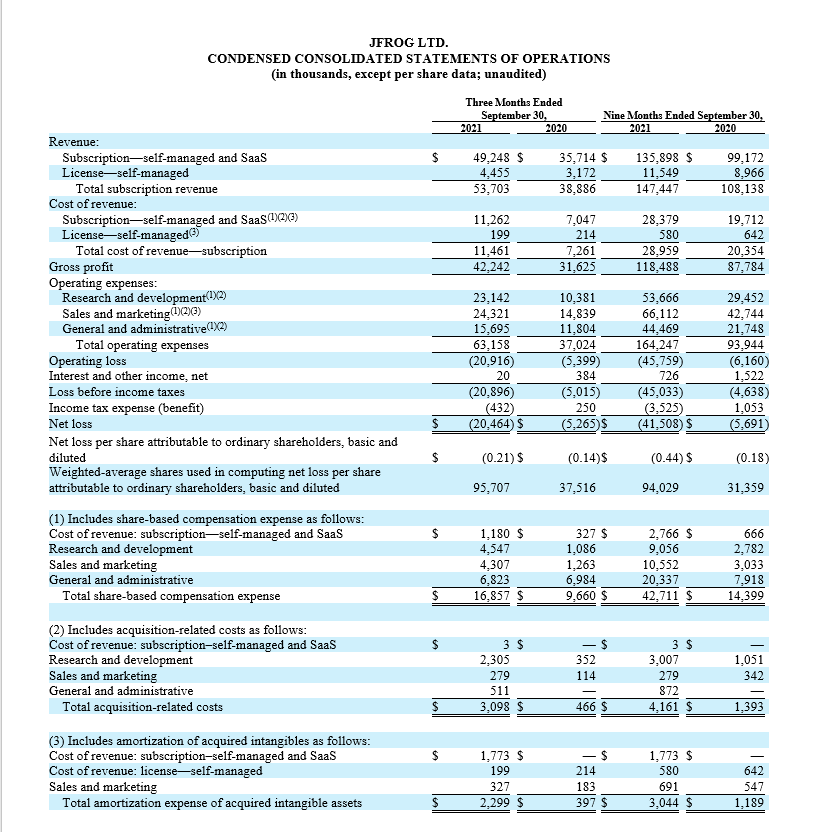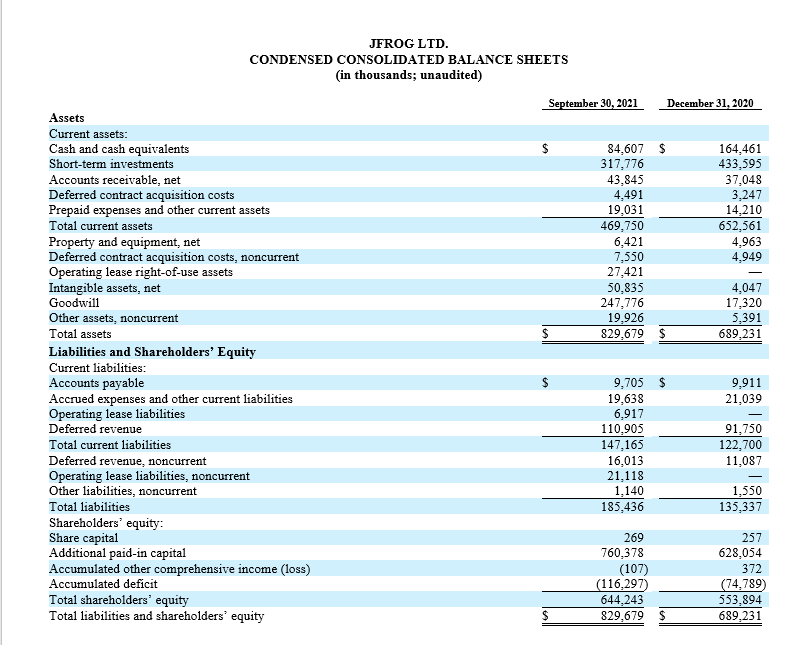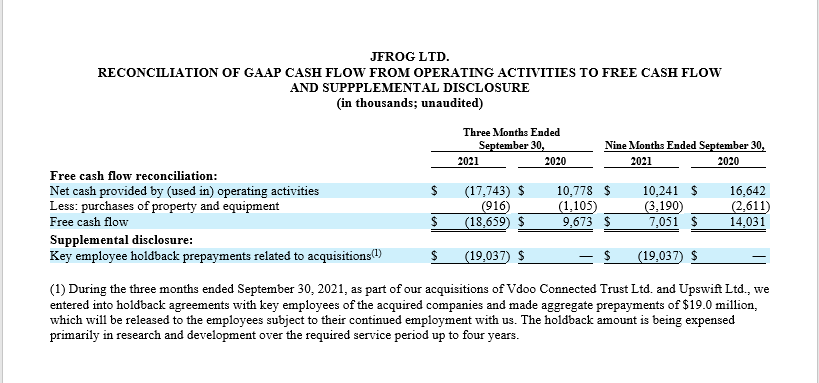JFrog Announces Third Quarter Fiscal 2021 Results
PRESS RELEASE, 2021年 11月 4日
Sunnyvale, Calif., November 4, 2021 — JFrog Ltd. (NASDAQ: FROG), the Liquid Software company and creators of the DevOps Platform, today announced financial results for its third quarter ended September 30, 2021.
“JFrog’s strong performance in Q3 across all metrics demonstrated the company’s commitment to both new business and expansion of existing customers,” said Shlomi Ben Haim, CEO and Co-Founder of JFrog. “We successfully delivered on numerous fronts including technology innovation, revenue growth, cloud expansion, net dollar retention and gross margin. We started the second half of 2021 strong, and we will continue investing in our team and technology to drive further growth.”
Third Quarter Financial Highlights
- Revenue for the third quarter of 2021 was $53.7 million, an increase of 38% over $38.9 million in the third quarter of 2020, and compared to 34% growth in the prior quarter.
- GAAP Gross Profit was $42.2 million; GAAP Gross Margin was 7%.
- Non-GAAP Gross Profit was $45.4 million; Non-GAAP Gross Margin was 84.5%.
- GAAP Operating Loss was ($20.9 million); GAAP Operating Margin was (38.9%).
- Non-GAAP Operating Income was $1.3 million; Non-GAAP Operating Margin was 2.5%.
- GAAP Net Loss Per Diluted Share was ($0.21); Non-GAAP Net Income Per Diluted Share was $0.01.
- Operating Cash Flow was ($17.7) million, with Free Cash Flow of ($18.7) million, due to $19.0 million in holdbacks related to recent acquisitions.
- Cash, Cash Equivalents and Investments were $402.4 million as of September 30, 2021.
Third Quarter & Recent Business Highlights
- Accelerating growth to 466 customers with ARR greater than $100k at quarter end, an increase of 49% from 313 as of September 30, 2020.
- Strong growth to 14 customers with ARR greater than $1 million at quarter end, an increase of 56% from 9 as of September 30, 2020.
- Cloud revenue in Q3 was $13.1 million, 50% growth over the same period last year, compared to 47% growth in the previous quarter. Cloud represented 24% of total revenue, up from 22% in the same period last year.
- Net Dollar Retention rate for the trailing four quarters remained at 129%.
- Customers using the complete JFrog Platform (Enterprise+ subscription) represented 34% of revenue in the third quarter of 2021, versus 19% in the same period last year.
- Completed the acquisition of Upswift to deliver the industry’s first complete development-to-device platform, expanding the total addressable market.
- Received U.S. Department of Defense “Iron Bank” certification for JFrog products to expand usage of JFrog in the government sector.
- Partnered with SBC&S, a SoftBank company, as part of the APAC channel program, to accelerate DevOps adoption in Japan with the JFrog Platform.
- Achieved CVE Numbering Authority (CNA) certification to contribute data to global security standards bodies, which is consumed by millions of developers that rely on CVEs as a trusted security source.
Fourth Quarter and Full Year 2021 Outlook
- Fourth Quarter 2021 Outlook:
- Revenue between $57.5 million and $58.5 million
- Non-GAAP operating income between $1 million and $1.0 million
- Non-GAAP net income per share between $00 and $0.01, assuming approximately 104 million weighted average diluted shares outstanding
- Full Year 2021 Outlook:
- Revenue between $205 million to $206 million
- Non-GAAP operating income between $2 million and $5.2 million
- Non-GAAP net income per share between $04 and $0.05, assuming approximately 104 million weighted average diluted shares outstanding
The section titled “Non-GAAP Financial Information” below describes our usage of non-GAAP financial measures. Reconciliations between historical GAAP and non-GAAP information are contained at the end of this press release following the accompanying financial data.
Conference Call Details
- Event: JFrog’s Third Quarter 2021 Financial Results Conference Call
- Date: Thursday, November 4, 2021
- Time: 2:00 p.m. PT (5:00 p.m. ET)
- Webcast Link: https://investors.jfrog.com/events-and-presentations
A live webcast of the conference call will be accessible from the investor relations website at https://investors.jfrog.com/events-and-presentations/events.
About JFrog
JFrog is on a mission to be the company powering all of the world’s software updates, driven by a “Liquid Software” vision to allow the seamless, secure flow of binaries from developers to the edge. The company’s end-to-end DevOps platform – the JFrog Platform – provides the tools and visibility required by modern organizations to solve today’s challenges across critical pieces of the DevOps cycle. JFrog’s hybrid, universal, multi-cloud DevOps platform is available as both self-managed and SaaS services on AWS, Microsoft Azure, and Google Cloud. JFrog is trusted by millions of users and thousands of customers, including a majority of the Fortune 100 companies that depend on JFrog solutions to manage their mission-critical software delivery pipelines. Learn more at jfrog.com.
Forward-Looking Statements:
This press release and the earnings call referencing this press release contain “forward-looking” statements, as that term is defined under the U.S. federal securities laws, including but not limited to statements regarding JFrog’s future financial performance, including our outlook for the fourth quarter and for the full year of 2021, our leadership position in the markets in which we participate, our ability to drive growth, our expectations regarding recent acquisitions by us, including our ability to successfully integrate the acquisition into our business operations, including the DevOps platform, and realize anticipated benefits and synergies from the acquisition, our ability to expand usage of our platform in the government sector, our ability to contribute data to global security standards bodies, and our ability to meet market demands. These forward-looking statements are based on JFrog’s current assumptions, expectations and beliefs and are subject to substantial risks, uncertainties, assumptions and changes in circumstances that may cause JFrog’s actual results, performance or achievements to differ materially from those expressed or implied in any forward-looking statement.
There are a significant number of factors that could cause actual results to differ materially from statements made in this press release and our earnings call, including but not limited to: risks associated with managing our rapid growth; our history of losses; our limited operating history; our ability to retain and upgrade existing customers our ability to attract new customers; our ability to effectively develop and expand our sales and marketing capabilities; our ability to integrate and realize anticipated synergies from acquisitions of complementary businesses; risk of a security breach; risk of interruptions or performance problems associated with our products and platform capabilities; our ability to adapt and respond to rapidly changing technology or customer needs; our ability to compete in the markets in which we participate; our ability to successfully integrate technology from recent acquisitions, including Upswift, into our offerings; our and Vdoo’s ability to provide continuity to our respective customers following our recent acquisitions, and our ability to realize innovations following the acquisition; general market, political, economic, and business conditions; and the duration and impact of the COVID-19 pandemic. Our actual results could differ materially from those stated or implied in forward-looking statements due to a number of factors, including but not limited to, risks detailed in our filings with the Securities and Exchange Commission, including in our annual report on Form 10-K for the year ended December 31, 2020, our quarterly reports on Form 10-Q, and other filings and reports that we may file from time to time with the Securities and Exchange Commission. Forward-looking statements represent our beliefs and assumptions only as of the date of this press release. We disclaim any obligation to update forward-looking statements.
About Non-GAAP Financial Measures:
JFrog discloses the following non-GAAP financial measures in this release and the earnings call referencing this press release: non-GAAP operating income (loss), non-GAAP gross profit, non-GAAP gross margin, non-GAAP operating expenses (research and development, sales and marketing, general and administrative), non-GAAP operating margin, non-GAAP net income (loss), non-GAAP net income (loss) per diluted share, non-GAAP net income (loss) per basic share, and free cash flow. JFrog uses each of these non-GAAP financial measures internally to understand and compare operating results across accounting periods, for internal budgeting and forecasting purposes, for short- and long-term operating plans, and to evaluate JFrog’s financial performance. JFrog believes they are useful to investors, as a supplement to GAAP measures, in evaluating its operational performance, as further discussed below. JFrog’s non-GAAP financial measures may not provide information that is directly comparable to that provided by other companies in its industry, as other companies in its industry may calculate non-GAAP financial results differently, particularly related to non-recurring and unusual items. In addition, there are limitations in using non-GAAP financial measures because the non-GAAP financial measures are not prepared in accordance with GAAP and may be different from non-GAAP financial measures used by other companies and exclude expenses that may have a material impact on JFrog’s reported financial results.
Non-GAAP financial measures should not be considered in isolation from, or as a substitute for, financial information prepared in accordance with GAAP.
A reconciliation of the historical non-GAAP financial measures to their most directly comparable GAAP measures has been provided in the financial statement tables included below in this press release. A reconciliation of non-GAAP guidance measures to corresponding GAAP measures is not available on a forward-looking basis without unreasonable effort due to the uncertainty regarding, and the potential variability of, reconciling items that may be incurred in the future such as share-based compensation, the effect of which may be significant.
JFrog defines non-GAAP gross profit, non-GAAP operating expenses (research and development, sales and marketing, general and administrative), non-GAAP gross margin, non-GAAP operating margin, non-GAAP operating income (loss) and non-GAAP net income (loss) as the respective GAAP balances, adjusted for, as applicable: (1) share-based compensation expense; (2) the amortization of acquired intangibles; (3) acquisition-related costs and (4) income tax effects. JFrog defines free cash flow as Net cash provided by (used in) operating activities, minus capital expenditures. Investors are encouraged to review the reconciliation of these historical non-GAAP financial measures to their most directly comparable GAAP financial measures.
Management believes these non-GAAP financial measures are useful to investors and others in assessing JFrog’s operating performance due to the following factors:
Share-based compensation. JFrog utilizes share-based compensation to attract and retain employees. It is principally aimed at aligning their interests with those of its shareholders and at long-term retention, rather than to address operational performance for any particular period. As a result, share-based compensation expenses vary for reasons that are generally unrelated to financial and operational performance in any particular period.
Amortization of acquired intangibles. JFrog views amortization of acquired intangible assets as items arising from pre-acquisition activities determined at the time of an acquisition. While these intangible assets are evaluated for impairment regularly, amortization of the cost of acquired intangibles is an expense that is not typically affected by operations during any particular period.
Acquisition-related costs. Acquisition-related costs include expenses related to acquisitions of other companies. JFrog views acquisition-related costs as expenses that are not necessarily reflective of operational performance during a period.
Income tax effects. JFrog’s non-GAAP financial results are adjusted for income tax effects related to these non-GAAP adjustments and changes in our assessment regarding the realizability of our deferred tax assets, if any. Excluding income tax effects of non-GAAP adjustments provides a more accurate view of JFrog’s operating results.
Non-GAAP weighted average share count. JFrog defines non-GAAP weighted-average shares used to compute non-GAAP net income (loss) per share, basic and diluted, as GAAP weighted average shares used to compute net income (loss) per share attributable to common shareholders, basic and diluted, adjusted to reflect the ordinary shares issued in connection with the IPO that are outstanding as of the end of the period as if they were outstanding as of the beginning of the period for comparability.
Additionally, JFrog’s management believes that the non-GAAP financial measure, free cash flow, is meaningful to investors because management reviews cash flows generated from operations after taking into consideration capital expenditures due to the fact that these expenditures are considered to be a necessary component of ongoing operations.
Operating Metrics
JFrog’s number of customers with annual recurring revenue (“ARR”) of $100,000 or more is based on the ARR of each customer, as of the last month of the quarter. JFrog’s number of customers with ARR of $1 million or more is based on the ARR of each customer, as of the last month of the quarter. JFrog defines ARR as the annualized revenue run-rate of subscription agreements from all customers as of the last month of the quarter. The ARR includes monthly subscription customers, so long as JFrog generates revenue from these customers. JFrog annualizes its monthly subscriptions by taking the revenue it would contractually expect to receive from such customers in a given month and multiplying it by 12.
JFrog’s net dollar retention rate compares its ARR from the same set of customers across comparable periods. JFrog calculates net dollar retention rate by first identifying customers (the “Base Customers”), which were customers in the last month of a particular quarter (the “Base Quarter”). JFrog then calculates the contracted ARR from these Base Customers in the last month of the same quarter of the subsequent year (the “Comparison Quarter”). This calculation captures upsells, contraction, and attrition since the Base Quarter. JFrog then divides total Comparison Quarter ARR by total Base Quarter ARR for Base Customers. JFrog’s net dollar retention rate in a particular quarter is obtained by averaging the result from that particular quarter with the corresponding results from each of the prior three quarters.
Investor Contact:
JoAnn Horne
jhorne@marketstreetpartners.com









